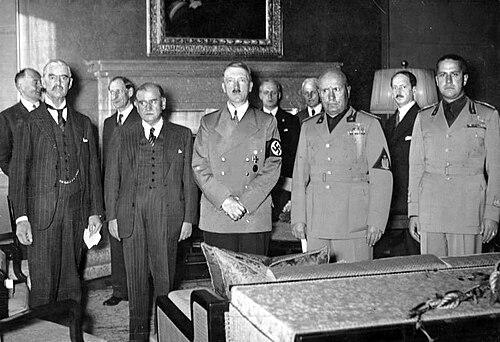
Back München-ooreenkoms Afrikaans Münchner Abkommen ALS معاهدة ميونخ Arabic اتفاقية ميونيخ ARZ Münxen sazişi Azerbaijani Мюнхенскае пагадненне 1938 года Byelorussian Мюнхэнскае пагадненьне BE-X-OLD Мюнхенско споразумение Bulgarian Minhenski sporazum BS Acord de Múnic Catalan
 From left to right: Neville Chamberlain, Édouard Daladier, Adolf Hitler, Benito Mussolini, and Galeazzo Ciano pictured before signing the Munich Agreement (1938) | |
| Signed | 30 September 1938 |
|---|---|
| Location | Munich, Germany |
| Signatories | |
| Parties | |
The Munich Agreement[a] was reached in Munich on 30 September 1938, by Nazi Germany, the United Kingdom, the French Republic, and the Kingdom of Italy. The agreement provided for the German annexation of part of Czechoslovakia called the Sudetenland, where 3 million people, mainly ethnic Germans, lived.[1] The pact is known in some areas as the Munich Betrayal (Czech: Mnichovská zrada; Slovak: Mníchovska zrada), because of a previous 1924 alliance agreement[2] and a 1925 military pact between France and the Czechoslovak Republic.
Germany had started a low-intensity undeclared war on Czechoslovakia on 17 September 1938. In reaction, Britain and France on 20 September formally requested Czechoslovakia cede the Sudetenland territory to Germany. This was followed by Polish and Hungarian territorial demands brought on 21 and 22 September, respectively. Meanwhile, German forces conquered parts of the Cheb District and Jeseník District, where battles included use of German artillery, Czechoslovak tanks, and armored vehicles. Lightly armed German infantry briefly overran other border counties before being repelled. Poland grouped its army units near its common border with Czechoslovakia and conducted an unsuccessful probing offensive on 23 September.[3] Hungary moved its troops towards the border with Czechoslovakia, without attacking. The Soviet Union announced its willingness to come to Czechoslovakia's assistance, provided the Red Army would be able to cross Polish and Romanian territory; both countries refused.[4]
An emergency meeting of the main European powers–not including Czechoslovakia, although their representatives were present in the town, or the Soviet Union, an ally to France and Czechoslovakia–took place in Munich, on 29–30 September. An agreement was quickly reached on Adolf Hitler's terms, and signed by the leaders of Germany, France, Britain, and Italy. The Czechoslovak mountainous borderland marked a natural border between the Czech state and the Germanic states since the early Middle Ages; it also presented a major natural obstacle to a possible German attack. Strengthened by border fortifications, the Sudetenland was of absolute strategic importance to Czechoslovakia. On 30 September, Czechoslovakia submitted to the combination of military pressure by Germany, Poland, and Hungary, and diplomatic pressure by Britain and France, and agreed to surrender territory to Germany following the Munich terms.
The Munich Agreement was soon followed by the First Vienna Award on 2 November 1938, separating largely Hungarian inhabited territories in southern Slovakia and southern Subcarpathian Rus' from Czechoslovakia. On 30 November, Czechoslovakia ceded to Poland small patches of land in the Spiš and Orava regions.[5] In March 1939, the First Slovak Republic, a German puppet state, proclaimed its independence. Shortly afterwards, Hitler reneged on his promise to respect the integrity of Czechoslovakia by occupying the remainder of the country and creating the Protectorate of Bohemia and Moravia.[6] The conquered nation's military arsenal played an important role in Germany's invasions of Poland and France in 1939 and 1940.[7]
Much of Europe celebrated the Munich Agreement, as they considered it a way to prevent a major war on the continent.[8][9] Hitler announced that it was his last territorial claim in Northern Europe. Today, the Munich Agreement is regarded as a failed act of appeasement, and the term has become "a byword for the futility of appeasing expansionist totalitarian states."[10]
Cite error: There are <ref group=lower-alpha> tags or {{efn}} templates on this page, but the references will not show without a {{reflist|group=lower-alpha}} template or {{notelist}} template (see the help page).
- ^ see the text at "Munich Pact September 30, 1938"
- ^ Text in League of Nations Treaty Series, 1924 "vol. 23", pp. 164–169.
- ^ Cite error: The named reference
Goldstein E., Lukes, I.was invoked but never defined (see the help page). - ^ Ragsdale, Hugh (2001). "The Butenko Affair: Documents from Soviet-Romanian Relations in the Time of the Purges, Anschluss, and Munich". The Slavonic and East European Review. 79 (4): 698–720. doi:10.1353/see.2001.0004. ISSN 0037-6795. JSTOR 4213322.
- ^ Jesenský 2014, pp. 88–89.
- ^ office, Kafkadesk Prague (14 March 2021). "On this Day, in 1939: Slovakia declared its independence to side with Nazi Germany – Kafkadesk". kafkadesk.org. Retrieved 4 October 2021.
- ^ "Hoedl-Memoiren". joern.de. Retrieved 20 July 2019.
- ^ "What the British and the French Actually Thought About the Decision to Appease Hitler at Munich in 1938". Time. 24 September 2019. Retrieved 29 April 2024.
- ^ "What's the context? 30 September 1938: The Munich Agreement – History of government". history.blog.gov.uk. 30 September 2013. Retrieved 29 April 2024.
- ^ "Munich Agreement"